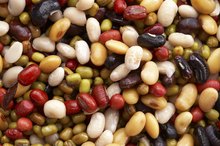What does fact checked mean?
At Healthfully, we strive to deliver objective content that is accurate and up-to-date. Our team periodically reviews articles in order to ensure content quality. The sources cited below consist of evidence from peer-reviewed journals, prominent medical organizations, academic associations, and government data.
The information contained on this site is for informational purposes only, and should not be used as a substitute for the advice of a professional health care provider. Please check with the appropriate physician regarding health questions and concerns. Although we strive to deliver accurate and up-to-date information, no guarantee to that effect is made.
Porterhouse Steak Nutrition
Porterhouse steak is a cut of meat derived from the location where the top loin and tenderloin join together. The Porterhouse resembles a large T-bone steak, and is one of the largest and thickest cuts of meat you can order. Red meat, such as Porterhouse steak, can provide much nutritional value in the way of protein and total calories, but can be potentially harmful when consumed in excess.
Calories Per Serving
While the U.S. Food and Drug Administration requires nutrition labels to report based on a 3-ounce serving of red meat, Porterhouse steaks usually range from 16 to 20 ounces when ordered at a restaurant. A 3-ounce serving of Porterhouse steak contains 250 calories, including 160 from fat. A 16-ounce Porterhouse steak would contain roughly 1,250 calories, and 800 from fat. Just one Porterhouse steak provides more than half the recommended 2,000 calories per day by the FDA.
- While the U.S. Food and Drug Administration requires nutrition labels to report based on a 3-ounce serving of red meat, Porterhouse steaks usually range from 16 to 20 ounces when ordered at a restaurant.
- A 3-ounce serving of Porterhouse steak contains 250 calories, including 160 from fat.
Fat And Cholesterol
How Much Protein Is in a Filet of Flounder?
Learn More
A 3-ounce serving of Porterhouse steak contains 18 grams of fat, according to the Wegmans meat nutrition page. This amount represents 28 percent of the daily recommended value. Furthermore, each serving contains 7 grams of saturated fat -- a specific type of fat associated with high cholesterol and cardiovascular disease. Porterhouse steak is also high in cholesterol, totaling 70 milligrams, or 23 percent the daily recommended value per serving. These totals escalate to more than five times when consuming a 16-ounce serving.
- A 3-ounce serving of Porterhouse steak contains 18 grams of fat, according to the Wegmans meat nutrition page.
- Porterhouse steak is also high in cholesterol, totaling 70 milligrams, or 23 percent the daily recommended value per serving.
Protein
A 3-ounce serving of Porterhouse steak contains 21 grams of protein, Wegmans reports. Therefore, a 16-ounce serving would contain more than 100 grams. While the Food and Drug Administration does not set daily requirements for protein, the Dietary Guidelines for Americans suggests consuming between 50 and 175 grams each day. A 16-ounce Porterhouse steak provides nearly all the recommended protein for the entire day. Furthermore, red meat is a high-quality protein containing essential amino acids needed to regulate numerous bodily functions.
- A 3-ounce serving of Porterhouse steak contains 21 grams of protein, Wegmans reports.
Micronutrients
Nutritional Values of Meat & Fish
Learn More
Micronutrients are substances that are not needed in the same quantities as fat, protein and carbohydrates, but still play an important role in the diet. Vitamins and minerals are micronutrients that must be obtained by eating a wide variety of foods. Porterhouse steak offers the minerals sodium and iron. Each 3-ounce serving contains 2 percent and 15 percent the daily recommended values for sodium and iron, respectively. Furthermore, Porterhouse steak offers an abundance of vitamin B-12, niacin, vitamin B-6, riboflavin and traces of many other vitamins.
- Micronutrients are substances that are not needed in the same quantities as fat, protein and carbohydrates, but still play an important role in the diet.
- Vitamins and minerals are micronutrients that must be obtained by eating a wide variety of foods.
Recommendations
While a staple in the American diet for centuries, more people are wisely substituting steak with leaner forms of protein, such as fish and soy. Fish offers nearly the same amount of protein per serving with less fat, cholesterol and saturated fat as red meat. The omega-3 fatty acids found in fish are associated with a number of health benefits as well. If you have to consume red meat, limit it to 4 ounces per serving, trim off the fat and do not fry it.
- While a staple in the American diet for centuries, more people are wisely substituting steak with leaner forms of protein, such as fish and soy.
Related Articles
References
- Beef, loin, tenderloin steak, boneless, separable lean only, trimmed to 0" fat, choice, cooked, grilled. FoodData Central. U.S. Department of Agriculture. Published April 1, 2019.
- Daley CA, Abbott A, Doyle PS, Nader GA, Larson S. A review of fatty acid profiles and antioxidant content in grass-fed and grain-fed beef. Nutr J. 2010;9:10. doi:10.1186/1475-2891-9-10
- Bradlee ML, Mustafa J, Singer MR, Moore LL. High-protein foods and physical activity protect against age-related muscle loss and functional decline. J Gerontol A Biol Sci Med Sci. 2017;73(1):88-94. doi:10.1093/gerona/glx070
- How to keep your immune system healthy. Academy of Nutrition and Dietetics. Updated 2018.
- Avoiding anemia boost your red blood cells. NIH News in Health. Updated 2014.
- Micha R, Michas G, Mozaffarian D. Unprocessed red and processed meats and risk of coronary artery disease and type 2 diabetes--an updated review of the evidence. Curr Atheroscler Rep. 2012;14(6):515-24. doi:10.1007/s11883-012-0282-8
- Pisazka V, Duscher G, Hodžić A, Reider N, Allerberger F. Alpha-gal allergy after a tick bite in Austria. Wien Klin Wochenschr. 2019;131(15-16):385-388. doi:10.1007/s00508-019-1506-5
- Saturated fat. American Heart Association. Updated 2020.
- Meadows L. What's your beef - prime, choice or select?. U.S. Department of Agriculture. Updated 2019.
- Nyquist KM, O'quinn TG, Drey LN, et al. Palatability of beef chuck, loin, and round muscles from three USDA quality grades. J Anim Sci. 2018;96(10):4276-4292. doi:10.1093/jas/sky305
- A fresh look at beef. Berkeley Wellness University of California. Updated 2016.
- Food safety risks for pregnant women. Academy of Nutrition and Dietetics. Updated 2018.
Writer Bio
Graham Ulmer began writing professionally in 2006 and has been published in the "Military Medicine" journal. He is a certified strength-and-conditioning specialist with the National Strength and Conditioning Association. Ulmer holds a Master of Science in exercise science from the University of Idaho and a Bachelor of Science in psychology from Washington State University.









